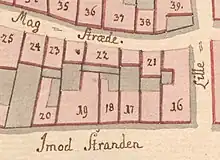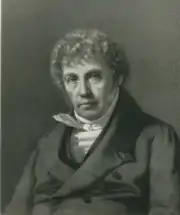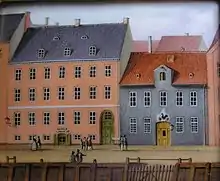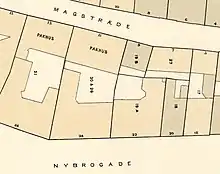| Nybrogade 22 | |
|---|---|
_01.jpg.webp) Nybrogade seen from the other side of the canal | |
| General information | |
| Architectural style | Neoclassical |
| Location | Copenhagen |
| Country | Denmark |
| Coordinates | 55°40′34.64″N 12°34′33.53″E / 55.6762889°N 12.5759806°E |
| Completed | 1853 |
| Client | Carl Løffler |
Nybroegade 22/Magstræde 9 is a complex of historic buildings overlooking Slotsholmen Canal and Christiansborg in central Copenhagen, Denmark. It consists of a five-storey apartment building from the 1850s in Nybrogade and a four-storey building from 1755 on the other side of the block in Magstræde (No. 9, heightened in the 1850s), separated from each other by a small, cobbled courtyard. The entire complex was listed on the Danish registry of protected buildings and places in 1945.
History
Origins

The site was formerly part of two properties. The eastern property was listed in Copenhagen's first cadastre of 1689 as No. 22 in Snaren's Quarter and belonged to skipper True Torkildsen. The western one was listed as No. 28 and belonged to assessor Hans Nielsen. The two properties were later merged into a single property. Adam Raben operated a successful soap manufactory on the site. The property was listed in the new cadastre of 1756 as No. 19 in Snaren's Quarter and belonged to his widow and business partners at that time. The property was known as Den Sorte Hane (The Bleck Cock).
The property belonged to the widow Anne Catrine Jørrensen at the 1787 census. She resided in the building with her two daughters (aged six and seven), a clerk (employee), two workers at the soap manufactory and one maid.[1]
The property was later passed down to her son Georg Jørgensen. He resided in the building with two of his sisters (aged 21 and 22), a soap manufacturer, three other male servants and one maid at the time of the 1801 census. The only other resident of the building then was the lodger Friderich Ernst Frankenau, a secretary, who resided in the building with one maid.[2]
Bech family

The just 20-year-old Jørgen Peter Bech (1782-1846) purchased the property in around 1802. He started out as a soap manufacturer but would later become a successful businessman with interests in shipping and general trading. Bech was granted citizenship as a merchant (grosserer) in 1806. He married on 23 January 1807 Ellen Sophie Magdalene Meyer (1784-1846). Her father, Jacob Albert Meyer, a grocer (urtekræmmer) and tea and porcelain merchant, had owned the property at Gammel Strand No. 13 (now Gammel Strand 44).

Bech was the maternal grandfather of the writer Wilhelm Bergsøe. Bergsøe often visited the house on Sundays and during holidays. He has written about his grandfather's home in Nybrogade in De forbistrede børn.[3]
Bech purchased the adjacent properties No. 20 & No. 26 (now Nybrogade 24) in the 1719s and charged Thomas Blom with the construction of a new building for the site. The family moved to their new home at what is now Nybrogade 24 in 1816. The Black Cock was from then on only used as his firm's office and as residence his long-term employee Nyholm as well as the family's physician.
Later history

In 1952, No. 19 was duivided into No. 19A /now Nybrogade 22) and No. 19 (Snaregade). The present building in Nybrogade was constructed in 1852-1853 for decorative painter Carl Løffler (1810-1853).[4] He already died from cholera on 28 July that same year as one of approximately 4,800 victims of the 1853 Copenhagen cholera outbreak. He is buried in Assistens Cemetery.[5]
Nybrogade 22 was home to just 18 residents at the 1860 census.[6]
1880 census
The property was home to 36 residents at the time of the 1880 census. August Ferdinand Fæster, a clothing retailer, resided in one of the ground-floor apartments with his daughter Amanda Emilie Augusta Fæster, Ida Hedevig Fjelstrup (pupil of N. Xahle's School, daughter of pastor Fjelstrup on Samsø) and one maid. Edvard Daniel Theodor Hvidt, a jurist in the Ministry of Justice, resided in the other ground-floor apartment with his wife Valdemar Hvidt. Anders Ferdinand Erlandsen, a businessman (grosserer), resided on the first floor with two sisters (aged 45 and 48) and one maid. Ludvig Christian Tuxen, a high-ranking civil servant (departementsdirektør), resided on the second floor with his wife Louise Frederikke Tuxen, two of her children (aged eight and 22) and one maid.Susanne Emilie Lawetz, an unmarried woman in her 40s, resided on the third floor with four school children (three of them sons of pastors on Zealand), 24-year-old Fanny Susanne Garde, her relative Valdemar Lawetz (clerk) and two maids. Mariane Elisabeth Henriette Hvidt, owner of Frihedslund, resided on the same floor with her daughter Therese Susanne Hvidt and the medicine student Daniel Villiam Lawetz. Vilhelmine Louise Løffler, a hostess of the building, resided on the fourth floor with her Emma Augusta Løffler (painter), her relative Dagmar Løffler and one maid. Oline Vilhelmine Petersen, a widow, resided on the fifth floor with her son Fritz Viggo Petersen, porcelain painter Christian Smith, ballet dancer Ludvig Theodor Smith and office courier.[7]
20th century
The property was home to 19 residents at the 1906 census. Hans Oscar Hansen, a lodger (clerk), resided on the ground floor. Frederikke Erlandsen and Jensine Erlandsen, two unmarried women in their 70s, resided on the first floor with one maid. Siegfred Nathalius Simonsen, a businessman, resided on the second floor with his wife Laura Michaeline Simonsen, their 25-year-old son Aage Julius Simonsen and one maid. Otto Steffensen, a conservator at Rosenborg Castle, resided on the third floor with his wife Harriet Steffensenm the relative Victoria Nyrup and one maid. Edvard Blaumøller, pastor of the Church of the Holy Ghost, resided on the fourth floor with his wife Elena Blaumøller and one maid. Margrethe Bergsøe, a female teacher, resided alone of the first floor. [8]
Architecture
Nybrogade 22
_03.jpg.webp)
Nybrogade 5 is constructed with five storeys above a walk-out basement. The seven-bays-wide, plastered facade is finished with shadow joints on the ground floor. It is painted in a ligh grew colour on the ground floor and white on the upper floors. Decorative elements include a cornice band above the ground floor. framing around the windows of the first to third floor, hood moulds above the windows of the first and second floor, rectangular niches below the first floor windows and a dentillated cornice below the roof. The tall Mansard roof is clad in black-glazed tile. It features three dormer windows towards the stret, The roof ridge is pierced by two chimneys. The main entrance in the central bay is raised three steps from street level. A short, two-bay side wing extends from the rear side of the building along the west side of a small courtyard. It is integrated with the front wing via a canted corner bay. All the facades that face the courtyard are rendered yellow. The stone tablet with the cock from the previous building on the site is embedded in the wall. Another stone tablet with an inscription in German is also embedded in the wall.[9]
Magstræde 9
.jpg.webp)
Magstræde 9 is constructed in brick, although with timber framing in the two gables, adhoining Nybrogade 7 and Nybrogade 11, respectively, with four storeys above a walk-out basement. The four-bays-wide facade is rendered in a pale yellow colour. The main entrance in the bay furthest to the left is topped by a blue-painted hood mould supported by corbels. The pitched roof is clad in red tile. It features two dormer windows towards the street and a three-bay window dormer towards the yard.
Today
Nybrogade 22 contains two small apartments on the ground floor and a single one on each of the upper floors.
See also
References
- ↑ "Folketælling - 1787 - Anne Catrine Jørrensen". Danishfamilysearch.dk (in Danish). Retrieved 29 November 2022.
- ↑ "Folketælling - 1787 - Anna Cathrine Jørgensen". Danishfamilysearch.dk (in Danish). Retrieved 29 November 2022.
- ↑ "Jens Peter Bech". barfod-barfoed.dk (in Danish). Retrieved 2 September 2019.
- ↑ "Jens Peter Bech". indenforvoldene.dk (in Danish). Retrieved 2 September 2019.
- ↑ "Folketælling - 1860 - Nybrogade, Matr. 19a, No. 22". gravsted.dk (in Danish). Retrieved 2 September 2019.
- ↑ "Folketælling - 1860 - Nybrogade, Matr. 21, No. 26". nishfamilysearch.dk (in Danish). Retrieved 7 March 2021.
- ↑ "Folketælling - 1787 - Nybrogade 22". Danishfamilysearch.dk (in Danish). Retrieved 29 November 2022.
- ↑ "Folketælling - 1787 - Nybrogade 22". Danishfamilysearch.dk (in Danish). Retrieved 29 November 2022.
- ↑ "Sag: Nybrogade 22 og Magstræde 9". Kulturstyrelsen (in Danish). Retrieved 2 September 2019.